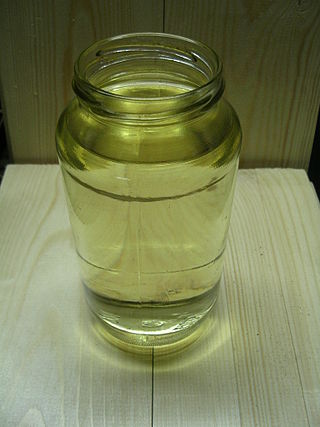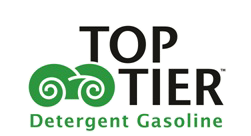
Gasoline or petrol is a transparent, slight yellowish petroleum-derived flammable liquid that is used primarily as a fuel in most spark-ignited internal combustion engines. It consists mostly of organic compounds obtained by the fractional distillation of petroleum, enhanced with a variety of additives. On average, U.S. refineries produce, from a barrel of crude oil, about 19 to 20 gallons of gasoline; 11 to 13 gallons of distillate fuel ; and 3 to 4 gallons of jet fuel. The product ratio depends on the processing in an oil refinery and the crude oil assay.
Texaco, Inc. is an American oil brand owned and operated by Chevron Corporation. Its flagship product is its fuel "Texaco with Techron". It also owned the Havoline motor oil brand. Texaco was an independent company until its refining operations merged into Chevron, at which time most of its station franchises were divested to Shell plc through its American division.

A filling station is a facility that sells fuel and engine lubricants for motor vehicles. The most common fuels sold in the 2010s were gasoline and diesel fuel.

Tetraethyllead (commonly styled tetraethyl lead), abbreviated TEL, is an organolead compound with the formula Pb(C2H5)4. It is a fuel additive, first being mixed with gasoline beginning in the 1920s as a patented octane rating booster that allowed engine compression to be raised substantially. This in turn increased vehicle performance and fuel economy. TEL was first synthesised by German chemist Carl Jacob Löwig in 1853. American chemical engineer Thomas Midgley Jr., who was working for General Motors, was the first to discover its effectiveness as an antiknock agent in 1921, after spending several years attempting to find an additive that was both highly effective and inexpensive.
An octane rating, or octane number, is a standard measure of a fuel's ability to withstand compression in an internal combustion engine without detonating. The higher the octane number, the more compression the fuel can withstand before detonating. Octane rating does not relate directly to the power output or the energy content of the fuel per unit mass or volume, but simply indicates gasoline's capability against compression.
Shell V-Power is the brand name given to Shell's enhanced high specification fuels for road motor vehicles including Shell V-Power Nitro+ and Shell V-Power Diesel. Introduced in Italy in 2001, Shell relaunched the fuel in March 2008, under the name Nitrogen-Enriched Shell V-Power, with nitrogen-containing detergents.

The LA engines are a family of pushrod OHV small block 90° V-configured gasoline engines built by Chrysler Corporation. It was factory-installed in passenger vehicles, trucks and vans, commercial vehicles, marine and industrial applications from 1964 through 1991 (318) & 1992 (360). The combustion chambers are wedge-shaped, rather than the polyspherical combustion chambers in the predecessor A engine or the hemispherical combustion chambers in the Chrysler Hemi engine. LA engines have the same 4.46 in (113 mm) bore spacing as the A engines. LA engines were made at Chrysler's Mound Road Engine plant in Detroit, Michigan, as well as plants in Canada and Mexico. The "LA" stands for "Light A", as the 1956 - 1967 "A" engine it was closely based on and shares many parts with was nearly 50 pounds heavier. The "LA" and "A" production overlapped from 1964 - 1966 in the US and through 1967 in export vehicles when the "A" 318 engine was phased out. Willem Weertman, who later became Chief Engineer – Engine Design and Development, was in charge of the conversion. The basic design of the LA engine would go unchanged through the development of the "Magnum" upgrade (1992-1993) and into the 2000s with changes to enhance power and efficiency.

Methylcyclopentadienyl manganese tricarbonyl (MMT or MCMT) is an organomanganese compound with the formula (C5H4CH3)Mn(CO)3. Initially marketed as a supplement for use in leaded gasoline, MMT was later used in unleaded gasoline to increase the octane rating. Following the implementation of the Clean Air Act (United States) (CAA) in 1970, MMT continued to be used alongside tetraethyl lead (TEL) in the US as leaded gasoline was phased out (prior to TEL finally being banned from US gasoline in 1995), and was also used in unleaded gasoline until 1977. Ethyl Corporation obtained a waiver from the U.S. EPA (Environmental Protection Agency) in 1995, which allows the use of MMT in US unleaded gasoline (not including reformulated gasoline) at a treat rate equivalent to 8.3 mg Mn/L (manganese per liter).

A flexible-fuel vehicle (FFV) or dual-fuel vehicle is an alternative fuel vehicle with an internal combustion engine designed to run on more than one fuel, usually gasoline blended with either ethanol or methanol fuel, and both fuels are stored in the same common tank. Modern flex-fuel engines are capable of burning any proportion of the resulting blend in the combustion chamber as fuel injection and spark timing are adjusted automatically according to the actual blend detected by a fuel composition sensor. This device is known as an oxygen sensor and it reads the oxygen levels in the stream of exhaust gasses, its signal enriching or leaning the fuel mixture going into the engine. Flex-fuel vehicles are distinguished from bi-fuel vehicles, where two fuels are stored in separate tanks and the engine runs on one fuel at a time, for example, compressed natural gas (CNG), liquefied petroleum gas (LPG), or hydrogen.

DENSO Corporation is a global automotive components manufacturer headquartered in the city of Kariya, Aichi Prefecture, Japan.
Fuel-saving devices are sold on the aftermarket with claims they may improve the fuel economy, the exhaust emissions, or optimize ignition, air flow, or fuel flow of automobiles in some way. An early example of such a device sold with difficult-to-justify claims is the 200 mpg‑US (1.2 L/100 km) carburetor designed by Canadian inventor Charles Nelson Pogue.
In automotive and aerospace engineering, a fuel gauge is an instrument used to indicate the amount of fuel in a fuel tank. In electrical engineering, the term is used for ICs determining the current State of Charge of accumulators.

A check engine light or malfunction indicator lamp (MIL), is a tell-tale that a computerized engine-management system used to indicate a malfunction. Found on the instrument panel of most automobiles, it usually bears the legend engine, check engine, service engine soon, maintenance required, emiss maint, or a pictogram of an engine—and when illuminated, it is typically an amber or red color.
E85 is an abbreviation for an ethanol fuel blend of between 51% and 83% denatured ethanol fuel and gasoline or other hydrocarbon (HC) by volume.
An antiknock agent is a gasoline additive used to reduce engine knocking and increase the fuel's octane rating by raising the temperature and pressure at which auto-ignition occurs. The mixture known as gasoline or petrol, when used in high compression internal combustion engines, has a tendency to knock and/or to ignite early before the correctly timed spark occurs.

Top Tier Detergent Gasoline and Top Tier Diesel Fuel are performance specifications and trademarks designed and supported by several automakers. BMW, General Motors, Fiat Chrysler Automobiles, Ford, Acura/Honda, Toyota, Volkswagen, Mercedes-Benz, Navistar, and Audi support the gasoline standard, while General Motors, Volkswagen, Detroit Diesel, and Navistar support the diesel standard. Each of these automakers recommends the use of Top Tier Detergent Gasoline in their owner's manuals. Top Tier fuels must maintain levels of detergent additives that are believed to result in a higher standard of engine cleanliness and performance as compared to the United States Environmental Protection Agency (EPA) requirement. In addition, Top Tier fuels may not contain metallic additives, which can harm the vehicle emission system and create pollutants. As of 2018, Top Tier Detergent Gasoline is available from 61 licensed retail brands, and Top Tier Diesel Fuel is available from 5 licensed retail brands.
Sensotronic Brake Control (SBC) is an electro-hydraulic brake system, where the wheel brake cylinders on a vehicle are operated through a servomechanism.
The Canadian Motor Vehicle Arbitration Plan (CAMVAP) is a dispute resolution program for consumers in Canada who are experiencing problems with the assembly of their vehicle or with how the manufacturer implements its new-vehicle warranty. CAMVAP covers new, used, owned or leased vehicles from the current model year and up to an additional four model years old.
The GM Instrument Cluster Settlement was a 2008 class action settlement awarded to owners of certain General Motors vehicles with allegedly defective speedometers. The settlement allows the owner or lessee to get their instrument cluster replaced under the terms of a special coverage adjustment to their factory standard warranty.

A gasoline pump or fuel dispenser is a machine at a filling station that is used to pump gasoline (petrol), diesel, or other types of liquid fuel into vehicles. Gasoline pumps are also known as bowsers or petrol bowsers, petrol pumps, or gas pumps.









